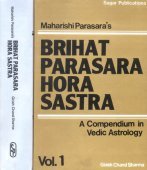Argala, Ārgala: 21 definitions
Introduction:
Argala means something in Hinduism, Sanskrit, the history of ancient India, Marathi, Hindi. If you want to know the exact meaning, history, etymology or English translation of this term then check out the descriptions on this page. Add your comment or reference to a book if you want to contribute to this summary article.
Alternative spellings of this word include Argal.
Images (photo gallery)
In Hinduism
Natyashastra (theatrics and dramaturgy)
Source: Wisdom Library: Nāṭya-śāstraArgala (अर्गल).—One of the 108 karaṇas (minor dance movement) mentioned in the Nāṭyaśāstra chapter 4. The instructions for this argala-karaṇa is as follows, “feet stretched backwards and kept two Tālas and a half apart, and hands moved in conformity with these.”.
A karaṇa represents a minor dance movements and combines sthāna (standing position), cārī (foot and leg movement) and nṛttahasta (hands in dancing position).
Source: Shodhganga: Elements of Art and Architecture in the Trtiyakhanda of the Visnudharmottarapurana (natya)Ārgala (आर्गल) refers to one of the 108 kinds of Karaṇa (“coordination of precise movements of legs and hands”), according to the Viṣṇudharmottarapurāṇa, an ancient Sanskrit text which (being encyclopedic in nature) deals with a variety of cultural topics such as arts, architecture, music, grammar and astronomy.—According to the Viṣṇudharmottarapurāṇa, karaṇas are the coordination of precise movements of legs and hands performed in a particular posture. The Nāṭyaśāstra also gives its view point in the same spirit. In the Viṣṇudharmottarapurāṇa, one hundred and eight kinds of karaṇas are accepted, e.g., Ārgala.

Natyashastra (नाट्यशास्त्र, nāṭyaśāstra) refers to both the ancient Indian tradition (shastra) of performing arts, (natya—theatrics, drama, dance, music), as well as the name of a Sanskrit work dealing with these subjects. It also teaches the rules for composing Dramatic plays (nataka), construction and performance of Theater, and Poetic works (kavya).
Shaktism (Shakta philosophy)
Source: Wisdom Library: ŚāktismArgala (अर्गल) refers to one of the 53 gods to be worshipped in the northern quarter and given pāyasa (rice boiled in milk) according to the Vāstuyāga rite in Śaktism (cf. Śāradātilaka-tantra III-V). The worship of these 53 gods happens after assigning them to one of the 64 compartment while constructing a Balimaṇḍapa. Vāstu is the name of a prodigious demon, who was killed by 53 gods (e.g., Argala).
Source: Google Books: ManthanabhairavatantramArgala (अर्गल) refers to the “chain” (of a door), according to the Kaulajñānanirṇaya.—Accordingly, “The Nameless (energy) [i.e., anāmā] is fixed in the Heart [i.e., hṛdaya]. This is the Gesture (mudrā) that bestows the goddess. If one sees her in the End of the Twelve, she shines (like) a necklace of gems. This is the Gesture (mudrā) called Anāmā; once (it is) known (one attains) the (liberated) sky-faring state. O beloved, one must break though the door which, endowed with consciousness, is sealed with the Five Seals (of the lower Wheels) and is well obstructed by the chain (of the door) [i.e., argala]. [...]”.

Shakta (शाक्त, śākta) or Shaktism (śāktism) represents a tradition of Hinduism where the Goddess (Devi) is revered and worshipped. Shakta literature includes a range of scriptures, including various Agamas and Tantras, although its roots may be traced back to the Vedas.
Vastushastra (architecture)
Source: OpenEdition books: Architectural terms contained in Ajitāgama and RauravāgamaArgala (अर्गल) refers to “horizontal lock §§ 3.38; 4.37.”.—(For paragraphs cf. Les enseignements architecturaux de l'Ajitāgama et du Rauravāgama by Bruno Dagens)

Vastushastra (वास्तुशास्त्र, vāstuśāstra) refers to the ancient Indian science (shastra) of architecture (vastu), dealing with topics such architecture, sculpture, town-building, fort building and various other constructions. Vastu also deals with the philosophy of the architectural relation with the cosmic universe.
Kavya (poetry)
Source: Brill: Śaivism and the Tantric Traditions (kavya)Argala (अर्गल) refers to an “(ivory rod) bolt”, according to Bāṇa’s Kādambarī (p. 225).—Accordingly, while describing the shire of the Goddess Caṇḍikā, “[Then the portal to the sanctum sanctorum, a riot of colour and form:] She was being illuminated by the entrance, on which there were hanging cloths reddened by lamp-smoke, a row of bracelets made of peacock-throats festooned [over it], a garland of bells closely-set and pale with powdered flour-cakes, which supported two door-panels, [studded] with tin lion heads with thick, iron pins in their centers, barricaded with an ivory-rod bolt (datta-dantadaṇḍa-argala), carrying [what seemed to be] a necklace of sparkling bubbles that were mirrors oozing yellow, blue and red [light]”.

Kavya (काव्य, kavya) refers to Sanskrit poetry, a popular ancient Indian tradition of literature. There have been many Sanskrit poets over the ages, hailing from ancient India and beyond. This topic includes mahakavya, or ‘epic poetry’ and natya, or ‘dramatic poetry’.
India history and geography
Source: Cologne Digital Sanskrit Dictionaries: Indian Epigraphical GlossaryArgala.—(IA 19), a check; used in certain dates and translated as ‘checked by’; cf. dvy-argala-catvāriṃśat-samadhika- vatsara-sahasra, ‘one thousand years, increased by forty [which have run into and are] checked by two’, i. e. the year 1042. Note: argala is defined in the “Indian epigraphical glossary” as it can be found on ancient inscriptions commonly written in Sanskrit, Prakrit or Dravidian languages.

The history of India traces the identification of countries, villages, towns and other regions of India, as well as mythology, zoology, royal dynasties, rulers, tribes, local festivities and traditions and regional languages. Ancient India enjoyed religious freedom and encourages the path of Dharma, a concept common to Buddhism, Hinduism, and Jainism.
Languages of India and abroad
Marathi-English dictionary
Source: DDSA: The Molesworth Marathi and English Dictionaryargalā (अर्गला).—f S pop. argaḷā f or argaḷa f m A bar (as of a door or window). Ex. laṅkēci mahādvārīñci argaḷā || 2 A manacle or a fetter. 3 fig. Check, curb, restraint; a let or bar. v ghāla.
Source: DDSA: The Aryabhusan school dictionary, Marathi-Englishargalā (अर्गला) [-ḷā-ḷa, -ळा-ळ].—f A bar, check, curb. A fetter
Marathi is an Indo-European language having over 70 million native speakers people in (predominantly) Maharashtra India. Marathi, like many other Indo-Aryan languages, evolved from early forms of Prakrit, which itself is a subset of Sanskrit, one of the most ancient languages of the world.
Sanskrit dictionary
Source: DDSA: The practical Sanskrit-English dictionaryArgala (अर्गल) or Argalā (अर्गला).—[arja kalac nyaṅkvādi° kutvam Tv.]
1) A wooden bolt, pin, bar &c. (for fastening a door or the cover of a vessel), a bolt, latch, bar; पुरार्गलादीर्घभुजो वुभोज (purārgalādīrghabhujo vubhoja) R.18.4;16.6; अनायतार्गलम् (anāyatārgalam) Mṛcchakaṭika 2; ससंभ्र- मेन्द्रद्रुतपातितार्गला निमीलिताक्षीव भियाऽमरावती (sasaṃbhra- mendradrutapātitārgalā nimīlitākṣīva bhiyā'marāvatī) K. P.1; दत्तं च बहिरर्गलम् (dattaṃ ca bahirargalam) Kathāsaritsāgara 4.62 bolted from without; oft. used figuratively in the sense of a bar, impediment, something intervening as an obstruction; वाक्यार्गलया निवारिताः (vākyārgalayā nivāritāḥ) Pañcatantra (Bombay) 2; Śiśupālavadha 2.118; ईप्सितं तदवज्ञानाद्विद्धि सार्गलमात्मनः (īpsitaṃ tadavajñānādviddhi sārgalamātmanaḥ) R.1. 79 obstructed; वार्यर्गलाभङ्ग इव प्रवृत्तः (vāryargalābhaṅga iva pravṛttaḥ) 5.45; कण्ठे केवलमर्गलेव निहिता जीवस्य निर्गच्छतः (kaṇṭhe kevalamargaleva nihitā jīvasya nirgacchataḥ) K. P.8; see अनर्गल (anargala) also.
2) A wave or billow.
3) The leaf of a door (kapāṭam).
4) A kind of 'stotra' or hymn.
Derivable forms: argalaḥ (अर्गलः), argalam (अर्गलम्).
See also (synonyms): argalī.
--- OR ---
Ārgala (आर्गल).—[argalameva svārthe aṇ] A bolt or bar; see अर्गलम् (argalam).
Derivable forms: ārgalaḥ (आर्गलः).
See also (synonyms): ārgalī.
Source: Cologne Digital Sanskrit Dictionaries: Shabda-Sagara Sanskrit-English DictionaryArgala (अर्गल).—mf. (-laḥ-lā or -lī) A wooden bolt or pin for fastening a door. mfn.
(-laḥ-lā-laṃ) A surge or billow. E. arja to gain. kalac affix, ja becomes ga, and the fem. takes both ṭāp and ṅīp.
--- OR ---
Ārgala (आर्गल).—mf. (-laḥ-lī) A bolt or bar: see argala.
Source: Cologne Digital Sanskrit Dictionaries: Benfey Sanskrit-English DictionaryArgala (अर्गल).—m., f. lā, and n. A wooden bolt, or pin for fastening a door, [Kathāsaritsāgara, (ed. Brockhaus.)] 4, 56; [Pañcatantra] 105, 5.
Source: Cologne Digital Sanskrit Dictionaries: Cappeller Sanskrit-English DictionaryArgala (अर्गल).—[masculine] [neuter], ā [feminine] bolt, bar, obstacle.
Source: Cologne Digital Sanskrit Dictionaries: Aufrecht Catalogus CatalogorumArgalā (अर्गला) as mentioned in Aufrecht’s Catalogus Catalogorum:—stotra. Oppert. Ii, 1727.
Source: Cologne Digital Sanskrit Dictionaries: Monier-Williams Sanskrit-English Dictionary1) Argala (अर्गल):—mfn. a wooden bolt or pin for fastening a door or the cover of a vessel, [Raghuvaṃśa] etc.
2) a bar, check, impediment, [ib.]
3) a wave, [cf. Lexicographers, esp. such as amarasiṃha, halāyudha, hemacandra, etc.]
4) mn. Name of a hell, [Padma-purāṇa v.]
5) Ārgala (आर्गल):—mf(ī). a bolt or bar (= argala q.v.), [cf. Lexicographers, esp. such as amarasiṃha, halāyudha, hemacandra, etc.]
Source: Cologne Digital Sanskrit Dictionaries: Yates Sanskrit-English Dictionary1) Argala (अर्गल):—[(laḥ-lā)] 1. m. f. A wooden bolt or pin; a surge or billow.
2) Ārgala (आर्गल):—[(laḥ-lī)] 1. m. 3. f. A bolt.
Source: DDSA: Paia-sadda-mahannavo; a comprehensive Prakrit Hindi dictionary (S)Argala (अर्गल) in the Sanskrit language is related to the Prakrit words: Aggala, Aggalā.
[Sanskrit to German]
Sanskrit, also spelled संस्कृतम् (saṃskṛtam), is an ancient language of India commonly seen as the grandmother of the Indo-European language family (even English!). Closely allied with Prakrit and Pali, Sanskrit is more exhaustive in both grammar and terms and has the most extensive collection of literature in the world, greatly surpassing its sister-languages Greek and Latin.
Hindi dictionary
Source: DDSA: A practical Hindi-English dictionaryArgala (अर्गल) [Also spelled argal]:—[[~lā]] (nm), ~[la:] (nf) a log for fastening a door, drawbar.
...
Kannada-English dictionary
Source: Alar: Kannada-English corpusArgala (ಅರ್ಗಲ):—
1) [noun] a wooden bolt, pin or bar for fastening a door; a latch.
2) [noun] an impediment; an obstacle.
--- OR ---
Argala (ಅರ್ಗಲ):—[adjective] strong; relatively big, huge.
--- OR ---
Argaḷa (ಅರ್ಗಳ):—[noun] = ಅರ್ಗಲ [argala]1.
--- OR ---
Argaḷa (ಅರ್ಗಳ):—[noun] a best, excellent man.
--- OR ---
Argaḷa (ಅರ್ಗಳ):—[adjective] = ಅರ್ಗಲ [argala]2.
Kannada is a Dravidian language (as opposed to the Indo-European language family) mainly spoken in the southwestern region of India.
See also (Relevant definitions)
Starts with: Argalaka, Argalanirgama, Argalapasha, Argalaprashna, Argalastava, Argalastotra, Argalastuti, Argalavihina.
Ends with (+9): Anargala, Anayatargala, Antargala, Atyargala, Bahirargala, Bhujargala, Candikargala, Dagargala, Dakargala, Dandargala, Dridhatoranargala, Jalargala, Karargala, Kargala, Khargala, Lohargala, Mamsargala, Mumgargala, Nirargala, Pratyargala.
Full-text (+21): Aggala, Anargala, Argada, Nirargala, Galeganda, Argalika, Argalastuti, Argalanirgama, Nirargalam, Argalastotra, Argaliya, Argalita, Irgala, Markaka, Pratyargala, Markata, Nirargalavac, Aghala, Aragalanem, Yugavya.
Relevant text
Search found 11 books and stories containing Argala, Argalā, Ārgala, Argaḷa; (plurals include: Argalas, Argalās, Ārgalas, Argaḷas). You can also click to the full overview containing English textual excerpts. Below are direct links for the most relevant articles:
Sahitya-kaumudi by Baladeva Vidyabhushana (by Gaurapada Dāsa)
Text 8.6 < [Chapter 8 - Literary Qualities]
Garga Samhita (English) (by Danavir Goswami)
Verse 1.11.44 < [Chapter 11 - Description of Śrī Kṛṣṇacandra’s Birth]
Vishnudharmottara Purana (Art and Architecture) (by Bhagyashree Sarma)
2.5. Karaṇa (movements of legs and hands) < [Chapter 3 - Drama and Dance]
Bhakti-rasamrta-sindhu (by Śrīla Rūpa Gosvāmī)
Verse 4.8.56 < [Part 8 - Compatible & Incompatible Mellows (maitrī-vaira-sthiti)]
Gati in Theory and Practice (by Dr. Sujatha Mohan)
Bhāgavata-mela Nāṭaka < [Chapter 4 - Practice of Gati]
Elucidation of Karaṇas related to Gati < [Chapter 2 - Concept and technique of Gati]
Gati pertaining to Characters < [Chapter 3 - Application of gati in Dṛśya-kāvyas]
Amarakoshodghatana of Kshirasvamin (study) (by A. Yamuna Devi)
Architecture (Buildings in a City) < [Chapter 4 - Cultural Aspects]
Related products

